
The Polyporales are an order of about 1800 species of fungi in the division Basidiomycota. The order includes some polypores as well as many corticioid fungi and a few agarics. Many species within the order are saprotrophic, most of them wood-rotters. Some genera, such as Ganoderma and Fomes, contain species that attack living tissues and then continue to degrade the wood of their dead hosts. Those of economic importance include several important pathogens of trees and a few species that cause damage by rotting structural timber. Some of the Polyporales are commercially cultivated and marketed for use as food items or in traditional Chinese medicine.

Suillus is a genus of basidiomycete fungi in the family Suillaceae and order Boletales. Species in the genus are associated with trees in the pine family (Pinaceae), and are mostly distributed in temperate locations in the Northern Hemisphere, although some species have been introduced to the Southern Hemisphere.

Meripilus giganteus is a polypore fungus in the family Meripilaceae. It causes a white rot in various types of broadleaved trees, particularly beech (Fagus), but also Abies, Picea, Pinus, Quercus and Ulmus species. This bracket fungus, commonly known as the giant polypore or black-staining polypore, is often found in large clumps at the base of trees, although fruiting bodies are sometimes found some distance away from the trunk, parasitizing the roots. M. giganteus has a circumboreal distribution in the northern Hemisphere, and is widely distributed in Europe. In the field, it is recognizable by the large, multi-capped fruiting body, as well as its pore surface that quickly darkens black when bruised or injured.

The Arthoniaceae are a family of lichenized, lichenicolous and saprobic fungi in the order Arthoniales. The Arthoniaceae is the largest family of Arthoniales, with around 800 species. Most species in Arthoniaceae belong in Arthonia which is the largest genus with 500 species. The second and third largest genus is Arthothelium with 80 species, and Cryptothecia with 60 species.

The Collemataceae are a lichenized family of fungi in the order Peltigerales. The family contains ten genera and about 325 species. The family has a widespread distribution.
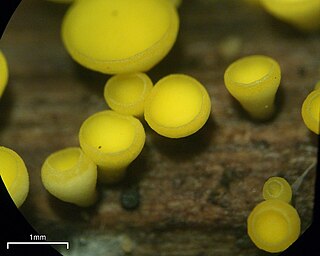
Bisporella citrina, commonly known as yellow fairy cups or lemon discos, is a species of fungus in the family Helotiaceae. The fungus produces tiny yellow cups up to 3 mm in diameter, often without stalks, that fruit in groups or dense clusters on decaying deciduous wood that has lost its bark. The widely distributed species is found in North Africa, Asia, Europe, North America, and Central and South America. Found in late summer and autumn, the fungus is fairly common, but is easily overlooked owing to its small size. There are several similar species that can in most cases be distinguished by differences in color, morphology, or substrate. Microscopically, B. citrina can be distinguished from these lookalikes by its elliptical spores, which have a central partition, and an oil drop at each end.

Gomphus clavatus, commonly known as pig's ears or the violet chanterelle, is an edible species of fungus in the genus Gomphus native to Eurasia and North America. The fruit body is vase- or fan-shaped with wavy edges to its rim, and grows up to 15–16 cm wide and 17 cm tall. The upper surface or cap is orangish-brown to lilac, while the lower spore-bearing surface, the hymenium, is covered in wrinkles and ridges rather than gills or pores, and is a distinctive purple color. Described by Jacob Christian Schäffer in 1774, G. clavatus has had several name changes and many alternative scientific names, having been classified in the genus Cantharellus, though it is not closely related to them.

Cortinarius violaceus, commonly known as the violet webcap or violet cort, is a fungus in the webcap genus Cortinarius native across the Northern Hemisphere. The fruit bodies are dark purple mushrooms with caps up to 15 cm (6 in) across, sporting gills underneath. The stalk measures 6 to 12 centimetres by 1 to 2 cm, sometimes with a thicker base. The dark flesh has a smell reminiscent of cedar wood. Forming symbiotic (ectomycorrhizal) relationships with the roots of various plant species, C. violaceus is found predominantly in conifer forests in North America and deciduous forests in Europe.

Grifola frondosa is a polypore mushroom that grows at the base of trees, particularly old growth oaks or maples. It is typically found in late summer to early autumn. It is native to China, Europe, and North America.
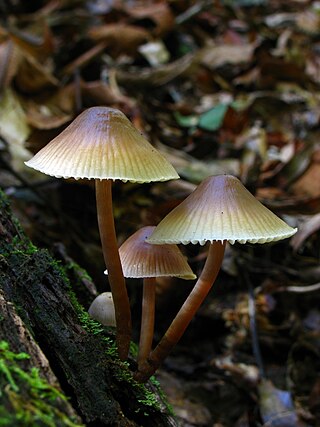
Mycena galericulata is a mushroom species commonly known as the common bonnet, the toque mycena, the common mycena or the rosy-gill fairy helmet. The type species of the genus Mycena was first described scientifically in 1772, but was not considered a Mycena until 1821. It is quite variable in color, size, and shape, which makes it somewhat difficult to reliably identify in the field. The mushrooms have caps with distinct radial grooves, particularly at the margin. The cap's color varies from grayish brown to dark brown and the shape ranges from bell-like to bluntly conical to flattened with an umbo. The stem is hollow, white, tough and thin, without a ring and often roots deeply into the wood on which it grows. The gills are white to grayish or even pinkish when mature and are connected by distinct cross-veins. The caps can reach 4 cm (1.6 in) in diameter, and have a mealy odor and taste. The spore print is white and the gills are pink at maturity, which can lead to possible confusion with species of the genus Pluteus. M. galericulata mushrooms grow mostly in clusters on the well-decayed stumps of deciduous and coniferous trees from spring to autumn. The species can generally be considered inedible. It is common and widespread in the entire temperate zone of the Northern Hemisphere, but it has also been reported from Africa.
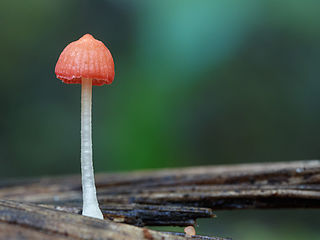
Atheniella adonis, which has the recommended name of scarlet bonnet in the UK, is a species of agaric in the family Cyphellaceae. Found in Asia, Europe, and North America, it produces small orangish to reddish mushrooms with caps up to 1.2 cm (0.5 in) in diameter and thin pinkish-white stems reaching 4 cm (1.6 in) long. The fungus typically grows in conifer woods and peat bogs, suggesting a preference for acidic environments. The appearance of several atypical fruitings on deciduous wood in the Netherlands in the late 1970s was attributed to increases in atmospheric pollution that raised the acidity of the wood substrate.

Mycena polygramma, commonly known as the grooved bonnet, is a species of mushroom in the family Mycenaceae. The inedible fruit bodies are small, pale gray-brown mushrooms with broadly conical caps, pinkish gills. They are found in small troops on stumps and branches of deciduous and occasionally coniferous trees. The mushroom is found in Asia, Europe, and North America, where it is typically found on twigs or buried wood, carrying out its role in the forest ecosystem by decomposing organic matter, recycling nutrients, and forming humus in the soil. M. polygramma contains two uncommon hydroxy fatty acids and is also a bioluminescent fungus whose intensity of light emission follows a diurnal pattern.
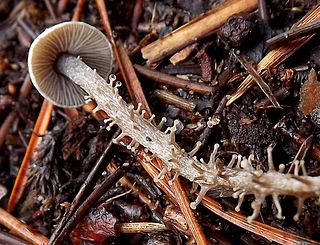
Dendrocollybia is a fungal genus in the family Tricholomataceae of the order Agaricales. It is a monotypic genus, containing the single species Dendrocollybia racemosa, commonly known as the branched collybia or the branched shanklet. The somewhat rare species is found in the Northern Hemisphere, including the Pacific Northwest region of western North America, and Europe, where it is included in several Regional Red Lists. It usually grows on the decaying fruit bodies of other agarics—such as Lactarius and Russula—although the host mushrooms may be decayed to the point of being difficult to recognize.

Serpula is a genus of fungi in the family Serpulaceae.
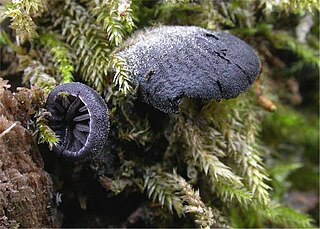
Resupinatus applicatus, commonly known as the smoked oysterling or the black jelly oyster, is a species of fungus in the family Tricholomataceae, and the type species of the genus Resupinatus. First described in 1786 as Agaricus applicatus by August Johann Georg Karl Batsch, it was transferred to Resupinatus by Samuel Frederick Gray in 1821.

Bondarzewia berkeleyi, commonly known as Berkeley's polypore, or stump blossoms, is a species of polypore fungus in the family Russulaceae. It is a parasitic species that causes butt rot in oaks and other hardwood trees. A widespread fungus, it is found in Africa, Asia, Europe, and North America.

Gymnopus fusipes is a parasitic species of gilled mushroom which is quite common in Europe and often grows in large clumps. It is variable but easy to recognize because the stipe soon becomes distinctively tough, bloated and ridged.
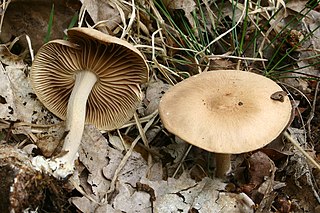
Collybiopsis peronata, also known as wood woolly-foot, is a species of gilled mushroom which is common in European woods.
The Latin word frondosa is the species name of many unrelated fungi, plants, and animals that have a frondose shape.
Inoderma is a genus of lichen-forming fungi in the family Arthoniaceae. It was resurrected for use in 2015 for a small group of species with the following features: elevated, white pruinose pycnidia, immersed to adnate white pruinose apothecia, and a weakly gelatinized hymenium. Inoderma byssaceum was assigned as the type species for the genus.


















